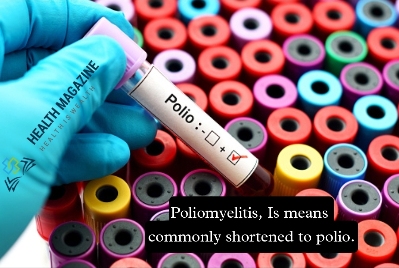
Polio
Poliomyelitis, Is means commonly shortened to polio, poliomyelitis is an infectious disease which is caused by the virus of the polio which is known as a polioviruses. In about 0.5 percent of cases in a humans, to affect the central nervous system it moves from the gut, and in the humans there is muscle weakness which can be resulting in a flaccid paralysis. This polioviruses can occur over a few hours to a few days. The weakness in this disease most often involves the human legs, but may less usually includes the muscles of the human neck, head, and diaphragm. Many people who are having this disease may be fully recover. In those who are with muscle weakness, about two to five percent of the child and 15 to 30 percent of younger age or adults to die. Up to 70 percent of people’s which are infected have no symptoms of this disease. Another 25 percent of people who are suffering from this disease may have some minor symptoms such as sore throat and a fever, and up to 5 percent have, neck stiffness, headache, and pains in the legs and arms.
These people are commonly back to normal health by preventing this disease within one or more than one week. Years after recovery from this disease, syndrome of post polio may occur, with a slow and unhealthy development of the body muscle weakness are similar to that which the person who is infected by this disease had during the initial infection. The term “poliomyelitis” is a infection which is used to identify the disease which is caused by the three serotypes of poliovirus. Two basic and the main patterns of this infection of polio are described: a minor and less illness which not involve the central nervous be system of the human body (CNS), sometimes it is called as a abortive poliomyelitis, and a major and a more illness in this disease involving the CNS, which may be non paralytic or paralytic. In most people with the common or normal immune system, a poliovirus infection in there body Is asymptomatic. Rarely, the infection of the polioviruses produces minor symptoms; these may include the upper respiratory infection of the tract such as sore throat , gastrointestinal disturbances ( vomiting, abdominal pain, nausea, or constipation, rarely, diarrhea), and influenza-like illness.
Poliomyelitis is a disease which is caused by the infection with the genus Enterovirus member known as a poliovirus. This group of the RNA viruses which is colonize the gastrointestinal tract – specifically the intestine and The incubation time ranges from four to thirty-five days, with a more common and usual span of five to twenty one days. PV causes and infects the disease in humans. Its structure is usually quite simple, which is composed of a single (+) sense RNA genome which is enclosed in to a protein shell which is known as a capsid. In addition to protecting the virus of this infection genetic material, the capsid proteins are enable poliovirus to infect the certain types of cells. Three types or the serotypes of the poliovirus which are identified – poliovirus type 1 (PV1), type 2 (PV2), and type 3 (PV3) – each are with the slightly different capsid protein. All three polioviruses types are extremely virulent and produce the same disease symptoms. PV1 is usually the most common encountered form, and this is the one most closely and common associated with the paralysis.
A polioviruses is a rare condition with a common and the similar presentation, polioviruses and nonpoliomyelitis, Which may result from the infections with the no poliovirus enteroviruses. There are two types of the vaccine which are used throughout the world or to the place to place to combat the polio. Both types induce the immunity to a polio, efficiently blocking of the person-to-person transmission of the wild poliovirus, thereby protecting both individual vaccine recipients and the wider community (so-called herd immunity


